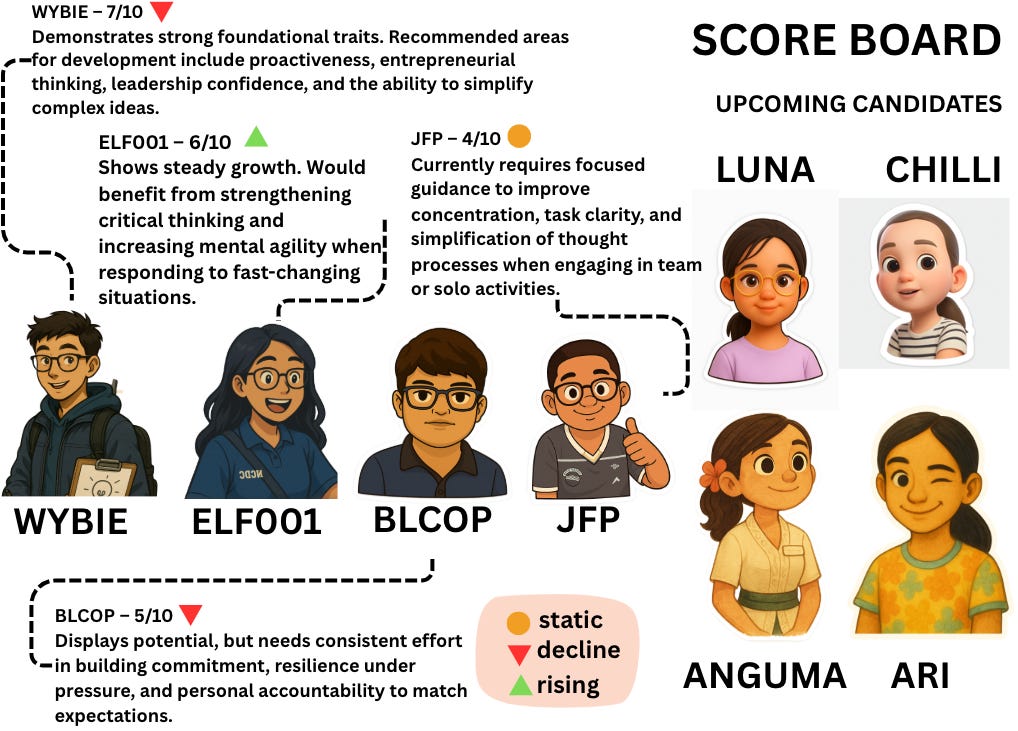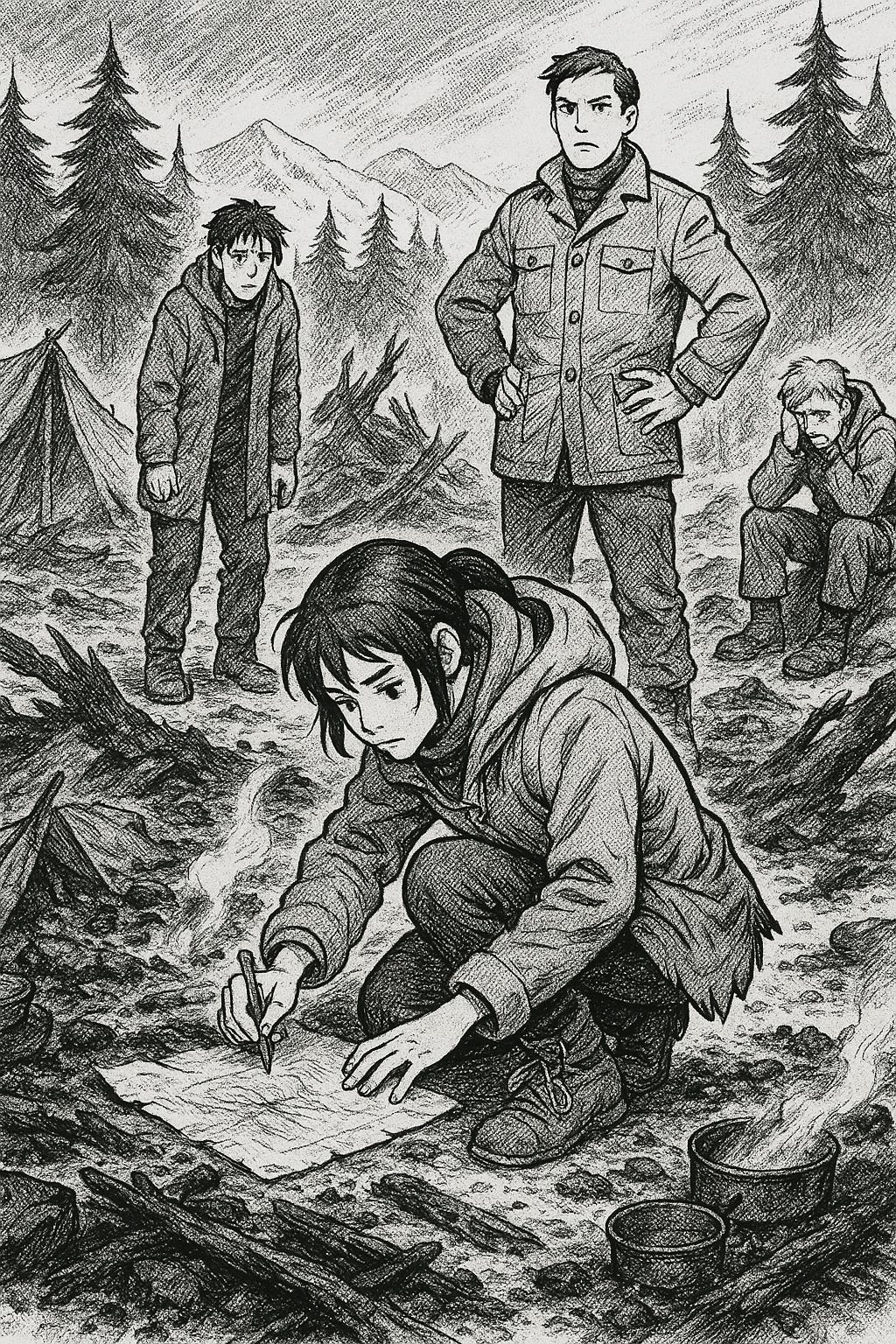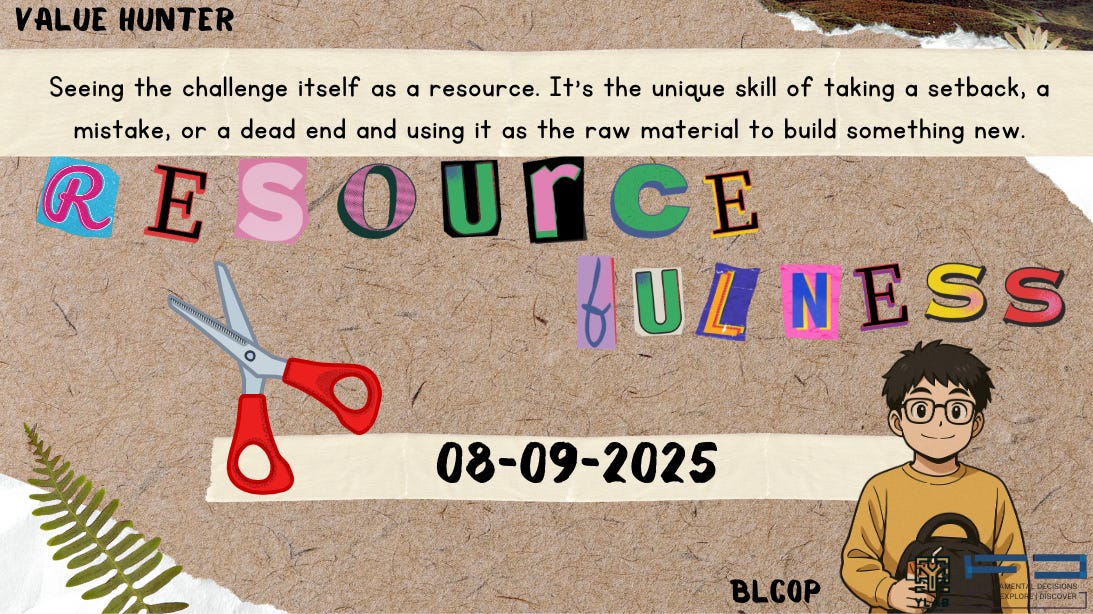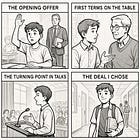Chapter 30 : The Resourceful Mind: Navigating with What You Have
When others see limitation, the resourceful see possibility. This is the art of turning scraps into strategy, and constraints into quiet yet powerful momentum.
Chapter 30 - RESOURCEFULNESS AUG 9 /GUEST Speaker VM03
LUNA - SESSIONS SUMMARY AUG 12
BLCOP - MATERIAL JUL 30 ( ORANGE - ONLY PROVIDED DOC ON AUG 1)
Chapter 29 MISSING COMMENTS AND RESPONSES TO EVALUATION FROM - [ WYBIE / BCLOP / CHILLI / ARY / LUNA ] : Review the evaluation and provide comments on specific actions you could take to improve.
Young Ambassadors – Latest Scoreboard
Take a minute to reflect
Upcoming Candidates
Luna
Anguma
Ari
Chilli
Story by BLCOP | Challenges by BLCOP - ( CAME IN LATE - DEMERIT FOR TIMELINESS AND ACCOUNTABILITY)
A. THE PASSAGE
The Whispering Well
In the shadow-draped vale of Ashwood, a deep-seated problem had taken root, one far more difficult than a simple drought. A creeping blight, a sickly gray film, was consuming the village's crops, leaving behind withered stalks and a harvest of broken hope. Despair was a tangible thing, settling over the community like a heavy shroud. The village elder, a stern man named Alden, insisted on traditional methods, urging the farmers to pray and to work harder, but the very soil seemed to have turned against them, its life slowly fading away.
Anya was a reclusive woman, known for her quiet walks through the woods and her peculiar, almost forgotten, knowledge of the local plants. While the villagers saw her as an eccentric and her deep understanding of the land as little more than old tales filled with baloney, Anya saw the blight not as a curse, but as a complex natural symptom. She observed that the blight was an exceptionally aggressive parasitic fungus, but its lifecycle was peculiar. It consumed the life from the plants, but in doing so, it left behind a rich, mineral-dense byproduct. The very gray film that was feared as a sign of death was, in fact, an incredible fertilizer.
This was her unique, often overlooked, resource. The villagers’ collective despair had blinded them to the subtle signs that lay hidden in plain sight, signs that pointed to a solution waiting to be discovered.
Anya's resourcefulness was not one of hammer and steel, but of memory and patient observation. She recalled ancient stories passed down through her family, tales that spoke of a deep, symbiotic relationship between decay and rebirth—a forgotten wisdom that had been eclipsed by more modern, yet less effective, farming practices. The key, she realized, wasn't to directly combat the blight, but to understand its nature and turn its destructive process into a creative one.
With a quiet and unwavering determination, she began her project. She carefully collected the withered stalks and the blight-covered soil, mixing them into a strange, earthy concoction with river silt and ash. It was a peculiar method, and the villagers regarded her with a mix of pity and suspicion. Her strange work seemed a distraction, a futile dance in the face of impending ruin.
But Anya was not attempting a brute-force fix; she was cultivating a solution. She took her mixture and meticulously worked it into a small, barren patch of earth, planting a handful of seeds and tending them with a quiet faith that defied the village's pervasive pessimism.
Days later, a small miracle began to unfold. While the rest of the village’s crops continued their slow decline, green shoots, strong and vibrant, emerged from Anya's experimental patch. The blight could not touch them. The villagers, at first in disbelief, came to see for themselves, their skepticism replaced by a deep and humble awe.
It was then that they understood the true nature of resourcefulness. It was not always about brute strength or clever inventions, but sometimes about having the profound wisdom to look for value in the overlooked, to find a solution in the very thing everyone else had cast aside. Anya’s unconventional wisdom, a resource more precious than any tool, had saved them all.
—----------------------------------------------------------------
Resourcefulness in real life often isn't about having a lot of tools or materials; it's about having the right perspective. The deepest form of resourcefulness is learning to see a problem not as a roadblock, but as a resource in itself. It's the ability to find the solution within the very thing that seems to be causing the failure.
Imagine a project that's failing. The team is behind schedule, the code is full of bugs, and morale is low. A resourceful leader doesn't just see a failed project; they see an opportunity to learn. They might identify the project's "bugs" as a critical list of features to avoid in the future, and the team's low morale as a chance to restructure for better collaboration. The problem becomes a detailed map for a more successful next attempt.
Let’s strive to make the most out of the smallest details and cherish them.
—---------------------------------------------------------------
A few core questions for the audience from me:
Question 1: The Unexpected Lesson: think about a time when a project or plan completely failed. What was the most valuable thing you gained from that failure—an unexpected piece of knowledge, a new connection, or a different skill?
Question 2: Flipping the Script: what is one problem you're currently facing that you see as a "roadblock"? How could you reframe that problem as a resource or a key piece of information you can use to find a new path forward?
Question 3: The Definition of Failure: we often see failure as a final destination. What if we redefine failure as simply "information"? How would that change the way you approach challenges in your life?
What are some of your experiences you would like to share? Feel free to open up in the comments and engage with other participants! Please enlist the Q No so we know what you are responding to.
JOIN US THIS WEEK @ THE EXPO and let’s discuss your academic notes on this exciting review ZOOM ID : 769 712 5558 (click ZOOM for the link or use the ZOOM ID)
PASS CODE : MEET
8:30 PM - 9:30 PM SINGAPORE TIME
7:30 PM - 8:30 PM VIETNAMESE TIME
6:00 PM - 7:00 PM INDIAN STANDARD TIME
4:30 PM - 5:30 PM OMAN TIME
The agenda this week
Guest Speaker for the week VM03
score board - Self reflection for AMBASSADORS : the quality of the program is determined by the filling up of the document and self reflection and responses to feedback already provided.
challenges for the week
practical use of school knowledge.
A New chapter 31 - awaits REMINDER ON THE DATES
Week of Chapter 31 - NEGOTIATION AUG 16 /GUEST Speaker SILVIABLCOP - SESSIONS SUMMARY AUG 19
ANGUMA - MATERIAL AUG 6
B. THE DIY CHALLENGE - SUBMITTED ON AUG 1
The 9 Traits that are bwing reviewed through the challenges
Creativity – Finding innovative ways to use resources beyond their obvious functions.
Efficiency – Maximizing output while minimizing input, waste, and effort.
Innovation – Developing new solutions that make optimal use of existing resources.
Problem-Solving – Tackling challenges using the tools and options currently available.
Optimization – Enhancing the value and performance of resources through smart adjustments.
Sustainability – Using resources responsibly to ensure long-term availability and impact.
Flexibility – Adjusting strategies and actions to fit changing conditions and constraints.
Collaboration – Coordinating and sharing resources effectively with others to achieve common goals.
Initiative – Proactively identifying and acting on alternative solutions when faced with limitations.
share with us how do you feel about the challenge.
TAKE THE CHALLENGE TO FIND OUT WHICH CHARACTER MATCHES YOU THE MOST!
🧭 The Compass Tinkerer
Core Traits: Creativity • Initiative • Problem-Solving
Essence: Always experimenting with what’s at hand, the Compass Tinkerer trusts their ability to forge a path—even when the map is missing.
Symbol: A compass made of mismatched parts, yet still pointing true.
🪡 The Patchweaver
Core Traits: Optimization • Flexibility • Collaboration
Essence: This character sees every leftover, gap, or flaw as a stitch waiting to be sewn. They thrive in collective environments, weaving solutions from what others overlook.
Symbol: A patchwork quilt forming a functional blueprint.
🧃 The Frugal Alchemist
Core Traits: Efficiency • Innovation • Sustainability
Essence: Turns limitations into leverage. The Frugal Alchemist doesn’t seek more—they make the most of less, often creating lasting value from the overlooked.
Symbol: A glass bottle catching sunlight to light a room.
🛶 The Adaptive Navigator
Core Traits: Flexibility • Problem-Solving • Initiative
Essence: When plans shift or tides change, this persona paddles calmly, reroutes with focus, and never lets uncertainty stall movement.
Symbol: A canoe mid-river with flexible oars, sailing into the fog.
🧤 The Silent Mechanic
Core Traits: Creativity • Optimization • Collaboration
Essence: Not flashy, but precise. The Silent Mechanic quietly repairs broken systems, often using subtle tweaks rather than grand overhauls.
Symbol: A worn leather glove holding a miniature wrench.
🔄 The Repurposer
Core Traits: Sustainability • Efficiency • Creativity
Essence: This character sees second lives in all things. They find joy in repurposing, reshaping, and regenerating value—both material and intangible.
Symbol: An origami bird made from an old blueprint.
C. SESSIONS SUMMARY by ANGUMA & LUNA
Date: 1O Aug 2025
Host: LUNA
Theme of the Day: The Resourceful Mind
The session opened with a calm, focused atmosphere. Members were invited to take part in a breathing exercise to center their attention before the main activities began. Most members appeared attentive and silent, as if following along even without video or microphones. Afterward, participants were encouraged to reflect on the exercise—considering changes from previous sessions in technique, atmosphere, or how it affected their heart rate, focus, and sense of calm. Questions were posed: “How does each member feel different or more aware?” and “What made you feel that way?”
Mr. VM then shared a personal story to illustrate resourcefulness. He recounted going to buy groceries when his bike tire was punctured en route. He asked members how they would solve the problem. When no one initially answered, he invited Luna to respond—she suggested asking for help or calling a taxi if extra money was available. Mr. VM then revealed he had used his spare money to fix his bike. Luna followed up with a thought-provoking question: “Do you think there is a difference between being creative and being resourceful?” Mr. VM explained that the two are closely linked, as resourcefulness often requires creativity. Other members joined in with questions before moving on to the challenge presentations.
The first presenter, JFP, shared an experience of trying to make cookies for a friend’s birthday without eggs and no time to buy them. He reflected on alternatives he could have tried—eggless cookies with milk or banana, or a simpler treat like chocolate-dipped strawberries. Luna asked him to clarify what actually happened, and he admitted he hadn’t known what to do at the time. Next, BLC OP presented an indoor plant holder made from an old cloth, followed by Chilli, who demonstrated a compass she created from classroom items like pencils, rulers, and rubber bands. Chilli’s presentation carried a meaningful moral: students should prioritize school supplies and learning over monetary concerns. ELF concluded the challenge section with a calm, well-prepared presentation of her idea for a plant pot.
Throughout the challenge round, Luna acted as the guide, assigning who would ask questions, with MIHF stepping in to assist her in leading. Most members completed their challenges successfully, though a few showed inconsistent engagement. The Vietnamese team once again demonstrated consistent attendance and participation.
In the closing segment, BC DF, with input from SAHN, introduced a video about a deer overcoming dangers from all directions while keeping its focus on drinking water—a metaphor for maintaining determination despite obstacles. Chilli shared a clear, systematic reflection on the video, while Anguma initially hesitated, receiving encouragement from BC DF. MIHF closed the discussion by praising members’ contributions and offering constructive corrections with motivating explanations. The session ended with words of thanks, leaving members with lessons on resourcefulness, focus, and resilience.
D. EVALUATION
1. Mr. VM – 8/10
Key Highlight:
Opened the session with a personal story that naturally prompted critical thinking and scenario-based problem-solving from members. Demonstrated Initiative by sharing a relatable challenge, and Collaboration by drawing responses from specific individuals to stimulate dialogue.
Weakness & Recommendation:
Tended to resolve his own scenario quickly instead of allowing more time for member exploration. Could strengthen Flexibility by letting participants navigate the ambiguity longer before stepping in, to deepen their Problem-Solving process.
2. Luna – 6/10
Key Highlight:
Consistently encouraged dialogue, posed probing questions (e.g., difference between creativity and resourcefulness), showing strong Collaboration, Initiative, and Optimization in guiding discussion.
Weakness & Recommendation:
Needed assistance in assigning questions during challenge rounds, indicating room to improve Efficiency in leadership role execution. Luna needs to be more confident in her speech as well. Recommend practicing real-time decision flow under pressure to sustain smooth facilitation.
3. JFP – 6/10
Key Highlight:
Shared a challenge scenario (making cookies without eggs) that clearly demonstrated Creativity and potential Sustainability through substitution ideas.
Weakness & Recommendation:
Admitted not acting on those ideas at the time, showing gaps in Initiative and Follow-Through. Should build habit of acting on spontaneous solutions in-the-moment rather than only in hindsight.
4. BLC OP – 7/10
Key Highlight:
Presented a creative plant holder from discarded cloth, effectively showcasing Innovation, Sustainability, and Optimization. Engaged actively with questions earlier in the session.
Weakness & Recommendation:
While the solution was resourceful, presentation detail could be strengthened to fully illustrate the Efficiency and Problem-Solving logic behind the design.
5. Chilli – 9/10
Key Highlight:
Delivered a detailed, meaningful compass project from classroom leftovers, integrating Creativity, Flexibility, and Collaboration in design. Moral takeaway linked to values beyond the task, indicating high Awareness and Sustainability mindset.
Weakness & Recommendation:
High performance overall; could add more Optimization rationale (e.g., why specific materials were chosen over others).
6. ELF – 8/10
Key Highlight:
Well-prepared and calm delivery of plant pot concept, showing Efficiency, Creativity, and Sustainability. Supported Luna actively when facilitation required backup.
Weakness & Recommendation:
Could deepen the Problem-Solving narrative by tying concept more explicitly to real-world constraints or needs.
7. Anguma – 5/10
Key Highlight:
Present for discussions and prompted to share on video reflection segment. Potential for Awareness and Problem-Solving was noted.
Weakness & Recommendation:
Hesitation and silence when called upon showed limited Initiative and Flexibility in live discussion. Anguma’s questions are fragmented and need to work on quality of the questions. Needs to practice quick-response thinking and verbalizing incomplete ideas without fear of imperfection.
8. MIHF – 7/10
Key Highlight:
Stepped in to assist facilitation smoothly, motivating participants and providing constructive feedback. Showed strong Collaboration, Initiative, and Optimization in group dynamics.
Weakness & Recommendation:
Could refine Efficiency in intervention timing—balancing between giving space for member-led solutions and stepping in.
9. BC DF – 7/10
Key Highlight:
Introduced closing video segment and directed reflective discussion, demonstrating Initiative and Collaboration.
Weakness & Recommendation:
While able to draw responses from certain members, some (e.g., Anguma) remained disengaged. Could develop more Flexibility in prompting techniques to engage reluctant speakers.
10. Mr. SAHN – 6/10
Key Highlight:
Provided support for closing activity and observation throughout the session.
Weakness & Recommendation:
Limited direct engagement; could leverage Collaboration and Initiative more actively by contributing observations or synthesis during reflective parts of the session.
11. Ela – 4/10
Key Highlight:
Was called upon during the resourcefulness discussion but gave no audible contribution. Presence indicates willingness to attend, which is a starting point for Collaboration.
Weakness & Recommendation:
Lack of verbal participation showed gaps in Initiative, Problem-Solving, and Flexibility. Needs to prepare at least one thought or example in advance of each session to build comfort in speaking.
12. Nhật Anh – 5/10
Key Highlight:
Confirmed reading the story and responded directly when asked, showing baseline Awareness and Collaboration.
Weakness & Recommendation:
Declined to contribute a question or story, indicating low Initiative and missed opportunities to apply Creativity or Problem-Solving. Recommend small, structured speaking opportunities to gradually increase active engagement.
13. Lacy – 6/10
Key Highlight:
Shared an example of “resourcefulness of the mind,” contributing a different perspective and showing Creativity, Flexibility, and Awareness.
Weakness & Recommendation:
Explanation lacked detail, which limited its impact on group learning. Could improve Optimization and Sustainability reasoning by adding clear, concrete examples to illustrate ideas.
Guardians, Kindly Take Note - TO DO
To support your child’s learning journey, please ensure the following are completed before the next session:
✅ Submit the weekly challenge
💬 Leave a comment on this week’s article
📅 Prepare to join the upcoming session - Aug 16
🗓 Next Session: Sat, 16 August
Our Audience reads from the following locations : Please help to spread the word….







Deras comment
After reading this interesting story, I concluded that you should never judge people without getting to know them first.
A simple person, like Anya, who is considered strange by society, is actually able to provide solutions to their problems.
So, it's possible that people we consider ordinary are actually better than us. So, start learning to appreciate everything and everyone without judgment.
Kunny comment
I once participated in a recitation competition at school, but I failed. Then I continued my recitation practice, and I've improved. My teacher said I was a leader in my recitation class.
It turns out I just learned that failure brings out the best in us if we keep trying.